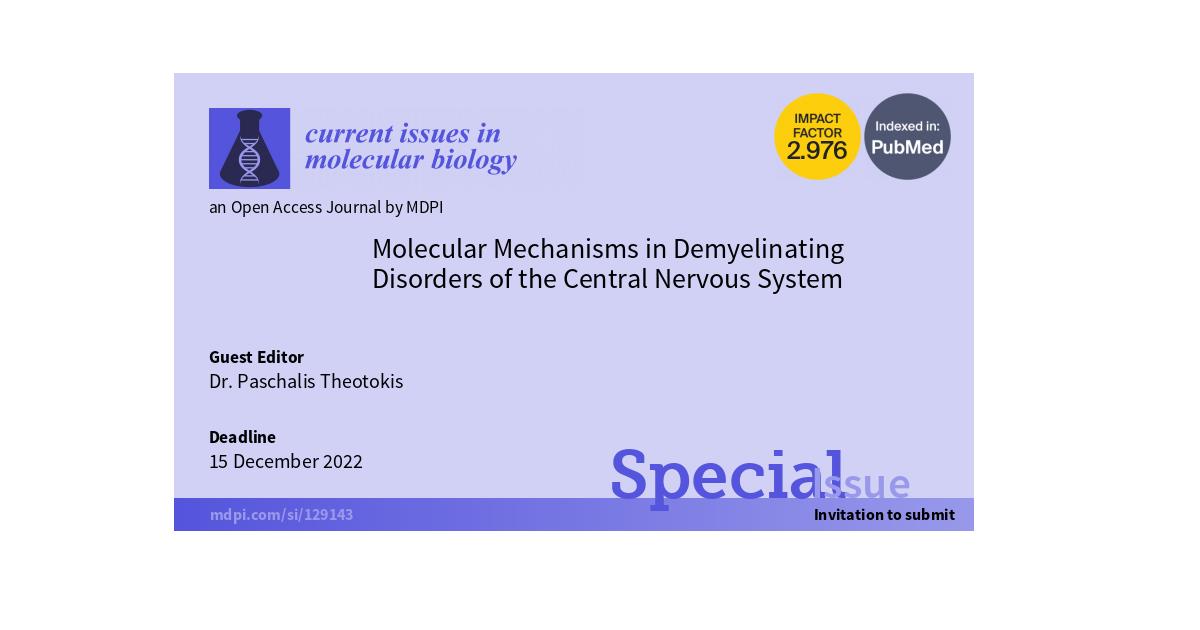Molecular Mechanisms in Demyelinating Disorders of the Central Nervous System
A special issue of Current Issues in Molecular Biology (ISSN 1467-3045). This special issue belongs to the section "Biochemistry, Molecular and Cellular Biology".
Deadline for manuscript submissions: closed (30 September 2023) | Viewed by 37746

Special Issue Editor
2. Laboratory of Histology and Embryology, Medical School, Aristotle University of Thessaloniki, Thessaloniki, Greece
Interests: neuroscience; multiple sclerosis; experimental autoimmune encephalomyelitis; intrathecal transplantation; stem cell differentiation; immunohistopathology; in situ hybridization; electron microscopy
Special Issues, Collections and Topics in MDPI journals
Special Issue Information
Dear Colleagues,
A demyelinating disease is a pathological condition of the nervous system that negatively affects the structure and function of the lipid sheath that surround axons, ultimately interfering with the nerve conduction. These lipid sheaths are lamellar membrane extensions of oligodendrocytes (OLs) in the central nervous system (CNS) and the Schwann cells in the peripheral nervous system (PNS). Myelinoclastic and leukodystrophic are the two categories into which demyelinating diseases have historically been divided. A typical, healthy myelin sheath is damaged in the first group as a result of a toxic, chemical, or autoimmune agent while genetic-based aberrant myelin that is degenerated is present in the latter one, better known as dysmyelination.
Among the three main inflammatory-based CNS demyelinating diseases are multiple sclerosis (MS), neuromyelitis optica spectrum disorder (NMOSD) and acute disseminated encephalomyelitis (ADEM). MS is the most prevalent one, affecting millions of people worldwide. Since etiology of these diseases is still largely unknown, there’s a need to establish new biomarkers and prioritize the development of experimental research, particularly in the molecular level. I hereby invite authors to submit original research, review articles or commentaries on molecular mechanisms that shed light to therapeutic strategies in demyelinating disorders of the CNS.
Dr. Paschalis Theotokis
Guest Editor
Manuscript Submission Information
Manuscripts should be submitted online at www.mdpi.com by registering and logging in to this website. Once you are registered, click here to go to the submission form. Manuscripts can be submitted until the deadline. All submissions that pass pre-check are peer-reviewed. Accepted papers will be published continuously in the journal (as soon as accepted) and will be listed together on the special issue website. Research articles, review articles as well as short communications are invited. For planned papers, a title and short abstract (about 100 words) can be sent to the Editorial Office for announcement on this website.
Submitted manuscripts should not have been published previously, nor be under consideration for publication elsewhere (except conference proceedings papers). All manuscripts are thoroughly refereed through a single-blind peer-review process. A guide for authors and other relevant information for submission of manuscripts is available on the Instructions for Authors page. Current Issues in Molecular Biology is an international peer-reviewed open access monthly journal published by MDPI.
Please visit the Instructions for Authors page before submitting a manuscript. The Article Processing Charge (APC) for publication in this open access journal is 2200 CHF (Swiss Francs). Submitted papers should be well formatted and use good English. Authors may use MDPI's English editing service prior to publication or during author revisions.
Keywords
- demyelination
- molecular mechanisms
- oligodendrocyte precursor cells
- myelinogenesis
- dysmyelination
- lipid metabolism
- microglia and macrophages
- experimental autoimmune
- encephalomyelitis
- biomarkers
- remyelination
Benefits of Publishing in a Special Issue
- Ease of navigation: Grouping papers by topic helps scholars navigate broad scope journals more efficiently.
- Greater discoverability: Special Issues support the reach and impact of scientific research. Articles in Special Issues are more discoverable and cited more frequently.
- Expansion of research network: Special Issues facilitate connections among authors, fostering scientific collaborations.
- External promotion: Articles in Special Issues are often promoted through the journal's social media, increasing their visibility.
- e-Book format: Special Issues with more than 10 articles can be published as dedicated e-books, ensuring wide and rapid dissemination.
Further information on MDPI's Special Issue polices can be found here.






